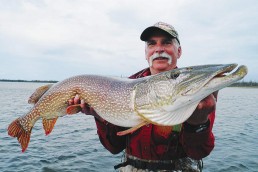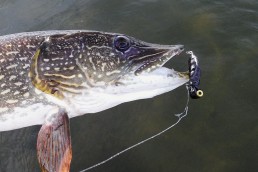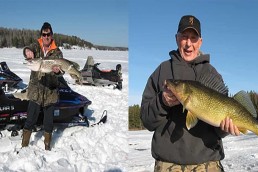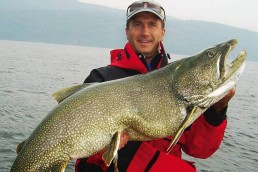Trophy Adventures in the Northwest Territories
As my friend Patrick Walsh and I entered the narrow side door of the Cessna Caravan in Yellowknife, I couldn’t recall ever having a bad day after getting into a floatplane to fish in Canada’s pristine northern wilderness. We were looking forward to an awesome ice-out pike adventure. In less than an hour the Twin Otter had arrived at Lac La Martre Adventures in the Northwest Territories. We set up our tackle in anticipation of catching big pike in shallow water—the pike did not disappoint.
Fish early spring
Fishing is about being in the right place at the right time and discovering the rhythm of a fish during a particular period. There are few better times of the year to catch a “trophy of a lifetime” than during the weeks after the ice has melted on a lake inhabited by good numbers of large pike. Ice-out is a window of opportunity to catch trophy fish in quantity because the large female pike are concentrated in predicable locations for a few magical weeks of shallow-water action. In the early spring large pike will be found in areas that warm up early such as shallow dark-bottom bays, flats and especially areas that have creeks or small river channels flowing into them. The northern pike begins its spawning rituals when the water temperatures are in the mid-30s to 45 degrees. Pike deposit their eggs in the weeds and other vegetation in these shallow areas and remain in these warmer areas after spawning to recover. They begin to feed with gusto as the rising temperatures energize their metabolisms. The large females will remain in this shallow water until it reaches the mid-40s to 50 degrees and then will migrate to the deeper, cooler water they prefer during the summer.
Pike will be looking for high-protein meals that take little effort to capture as they recover from the rigors of the spawn. Relatively small baits such as the 3/4- and 1-ounce Dardevle spoons worked slowly through the water column can be extremely effective on early-season pike. Using a plastic trailer on a spoon to add an element of seductive action is also effective for enticing big post-spawn pike to attack. For the fly angler, articulated Bunny flies, Clouser minnows and Murdich minnows are three favorite offerings when the pike are being finicky and need a more nuanced presentation than most hard baits are capable of. I always recommend heavy tackle when pursuing large trophy pike. A medium-heavy, 7-foot spinning or bait-casting rod, and at least a 9-weight fly rod are minimum standards to properly handle big fish.
Big spoons in skinny water
An excellent early-spring spoon technique is to use a large lightweight flutter spoon with a single hook in shallow water. It will enable you to keep the spoon moving slow and seductively without getting snagged on shallow structure. The Eppinger Dardevle Big Ed flutter spoon worked like a charm one morning as we fished a skinny water bay catching a dozen marauding pike in water less than 18 inches deep. This would not have been possible with a heavy casting spoon. Large flutter spoons are also very effective later in the season when weed beds are just a foot or two below the surface. You can run these lightweight spoons slowly just under the surface of heavy weed beds and pick up large pike, otherwise inaccessible with other presentations.
Enamored by tradition
Spoon fishing and fly fishing are two of the oldest, most traditional methods of presenting artificial lures to fish. Being marketing director of Eppinger Manufacturing Company has enabled me to experience many incredible fishing venues in North America and has quite literally fed my family for the past 15 years. Fly fishing has been my passion and has fed my soul with its wonder, beauty and mystique for over 50 years. Spoons and flies are simply my favorites, and I believe the most effective delivery systems to the magic world of fishing. I use both to my full advantage when pursuing large predatory fish.
The Gray Ghost and the trout bay
As I stood on the deck in front of the lodge at dawn sipping my first cup of coffee on day three, I had a feeling this would be a special day. The wind had subsided and the surface of the lake had smoothed out to a slate-like flatness. It would be a good day to travel and that’s just what we did. We headed for the north side of the lake for what had the potential to be an outstanding day of early-spring fishing for both lake trout and pike. I had fished this area last July with my son Dave and knew it could be one of the highlights of the trip—if the fish were on like last year. We had already enjoyed two excellent days of fishing, albeit with the wind blowing 15 to 25 mph making for difficult, yet manageable sight-fishing. Our guide Zack Brown has just led us to over 100 pike in the 8- to 12-pound range and 8 to 10 pike over 40 inches in two days, including a beautiful pike that qualified as a fly fishing line-class catch and release world record on day two!
As we entered the bay, Zack told us to get our spoons in the water as we were entering a trough that often had some nice trout in it. Not a minute later, my rod was struck by lake trout “lightning” and I reeled in a powerful 15-pound trout. I quickly released it and within minutes had another trout on. This time it was a 20-pound fish that had inhaled my 1-ounce Black Pearl Dardevle, nicknamed the “Gray Ghost,” and put up a stubborn underwater battle before finally surfacing to Zack’s net. This scenario repeated itself 7 or 8 times in a 30-minute period, and I was feeling pretty successful while my friend Patrick figured I must be cheating as he had not even had a bump on his Copper and Chartreuse Dardevle. Feeling guilty, I gave Patrick the “Gray Ghost” in a gesture of friendship and camaraderie. He had a fish on almost immediately as the spoon disappeared into the depths of the bay. I now watched as my friend caught fish after fish in the mid-teens and a few over 20 pounds with my lucky Black Pearl spoon. The 1-ounce Five of Diamonds I was offering was completely ignored by the trout. I figured this would be a good time to break out my fly rod and try trolling a large Black and Red Clouser minnow fly. The Black Clouser was almost immediately hit by a 25-pound trout when it got to about 10 feet in the water column. Lake trout put up an epic battle on a fly rod, and this fish was no exception as it sounded for the bottom and did his best to snap my fly rod for the next 5 minutes before giving up to Zack’s net. Patrick tried his hand with his fly rod with the same impressive results. We proceeded to catch almost 20 lake trout with nine of them weighing between 22 and 28 pounds on 1-ounce Gray Ghost Dardevle spoons and Black Clouser flies.
What an awesome surprise for an ice-out pike trip! Zack had never had a guest fly fish for lake trout. And he was pretty impressed with how effective large streamer flies are for big lake trout, and also surprised that a black spoon and fly would attract big trout like the force of gravity.
Mousing mayhem
Late in the afternoon Zack suggested we check out a couple of bays that had potential for topwater action. We had already caught nine lake trout over 20 pounds and several pike over 40 inches. There would be more surprises to come before we headed back to the lodge. We entered the bay through a cut between two rocky peninsulas to find a flat, windless whiskey-colored bay only a few feet deep with dozens of log-like serpents prowling under the surface. Neither of us had thought to bring any topwater baits for our spinning gear, but I did have a few floating foam mouse flies and we proceeded to lob them at the cruising pike. The reaction was swift and raucous as three or four pike at a time would swarm at the flies like wolves to a kill and T-bone them with the swagger only big pike can produce while launching themselves several feet out of the water like acrobatic crocodiles. We were now in the middle of a spectacular topwater pike bite. We had hits on almost every cast, but the hook-up rate was only about 50 percent, as the pike were so aggressive they often missed the mouse or we would short-strike the fish in anticipation as they torpedoed the fly with an explosive splash. We spent the next couple of hours immersed in “mousing” mayhem. That afternoon we caught several pike over 40 inches and dozens in the 30- to 35-inch range, all while chugging small black mouse flies across the surface of the bay. You can bet the next pike trip I won’t forget to bring a few topwater baits with me for my spinning rig.
In all the years I have fished, this day will stand as one of the most spectacular, with a mix of trophy pike, shallow-water lake trout over 20 pounds and an unbelievable topwater circus. As the day came to a close, Mother Nature treated us to a beautiful display of tumbling clouds rolling across the mirror-like surface of the lake as we headed toward the lodge for rest and reflection here in the Northwest Territories.
John Cleveland is marketing director for Eppinger Manufacturing Company and may be contacted at john@eppinger.net or 313-582-3205.
For more information contact Eppinger Manufacturing Company eppinger.net. Visit or contact Lac La Martre Adventures at nwtfishing.com. Contact Greg Dussome at 877-335-8855 or sherrid@telus.net. Contact Dave Thompson at 810-334-9381 or gobluedave@comcast.net.
MWO
SHARE THIS POST
Did you enjoy this post?
You can be among the first to get the latest info on where to go, what to use and how to use it!
John Cleveland
John Cleveland is the Marketing Director for Dardevle spoons, made by Eppinger Manufacturing Company. He is also an award-winning freelance outdoor writer and featured speaker on topics relating to his passion for catching big fish in wild places with fly and conventional tackle. Email: john@dardevle.com.





